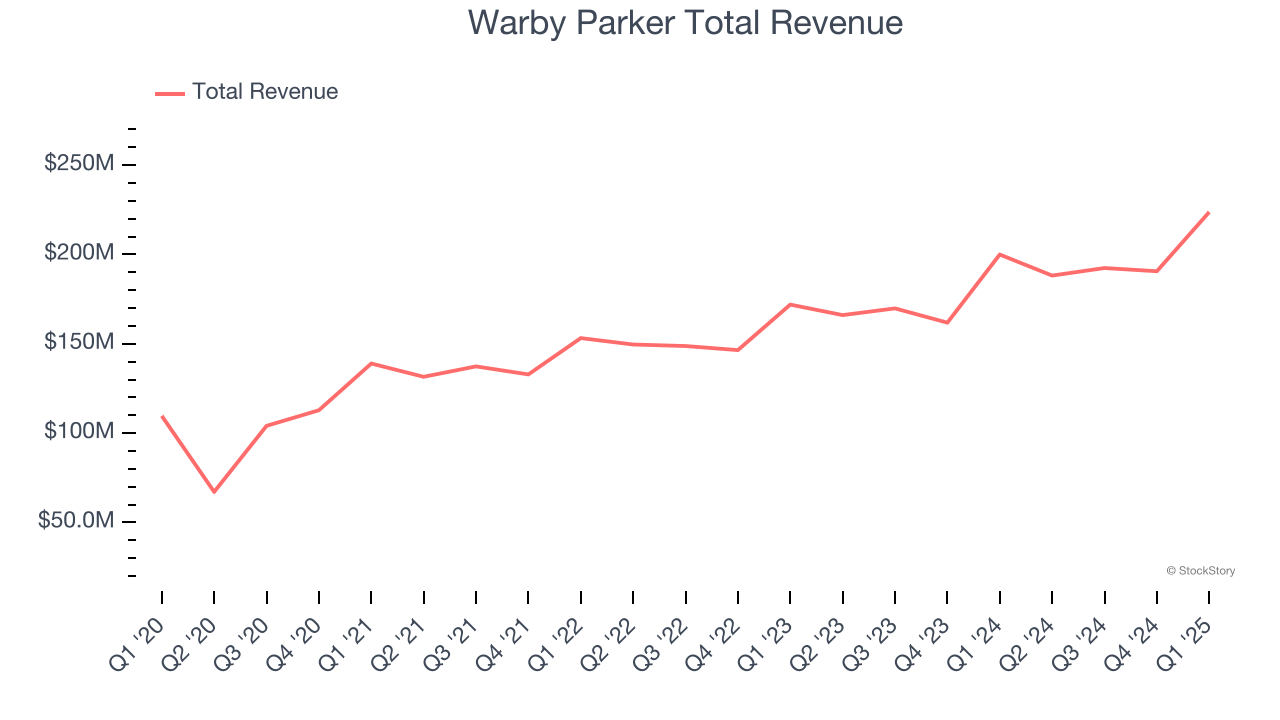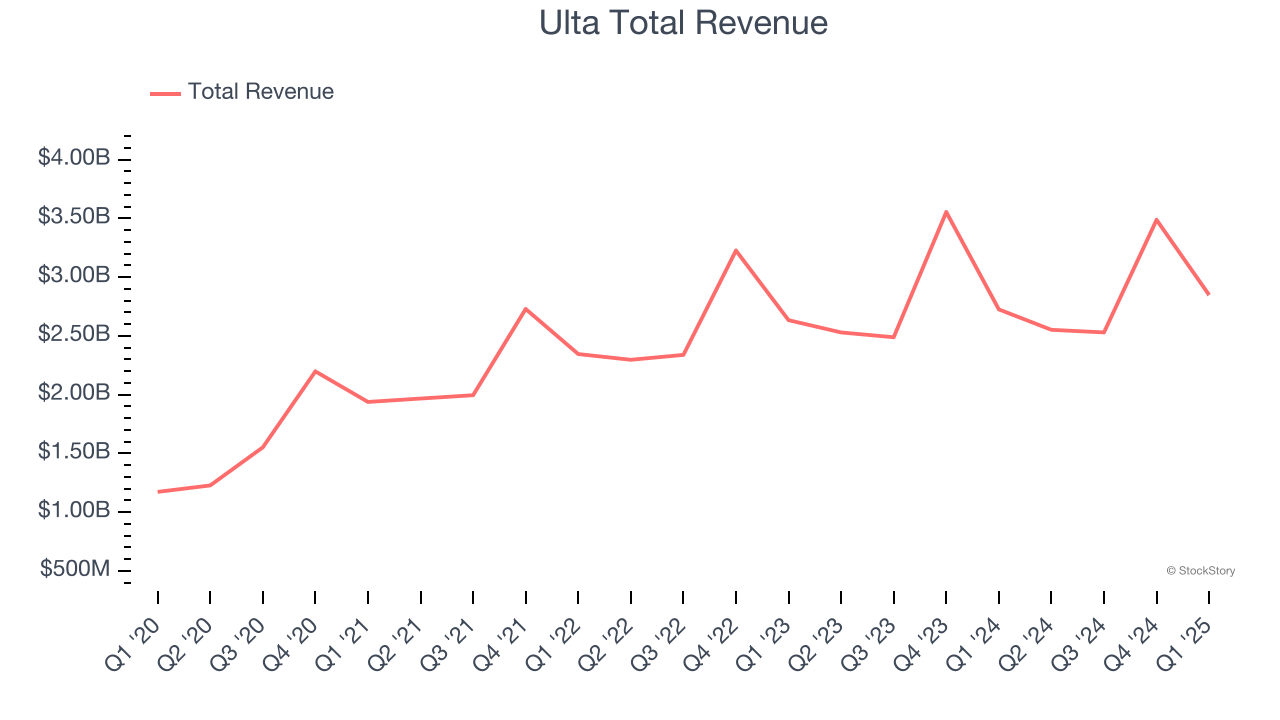
Earnings results often indicate what direction a company will take in the months ahead. With Q1 behind us, let’s have a look at Warby Parker (NYSE:WRBY) and its peers.
Beauty and cosmetics retailers understand that beauty is in the eye of the beholder, but a little lipstick, nail polish, and glowing skin also help the cause. These stores—which mostly cater to consumers but can also garner the attention of salon pros—aim to be a one-stop personal care and beauty products shop with many brands across many categories. E-commerce is changing how consumers buy cosmetics, so these retailers are constantly evolving to meet the customer where and how they want to shop.
The 4 beauty and cosmetics retailer stocks we track reported a mixed Q1. As a group, revenues along with next quarter’s revenue guidance were in line with analysts’ consensus estimates.
Luckily, beauty and cosmetics retailer stocks have performed well with share prices up 18.5% on average since the latest earnings results.
Warby Parker (NYSE:WRBY)
Founded in 2010, Warby Parker (NYSE:WRBY) designs, manufactures, and sells eyewear, including prescription glasses, sunglasses, and contact lenses, through its e-commerce platform and physical retail locations.
Warby Parker reported revenues of $223.8 million, up 11.9% year on year. This print fell short of analysts’ expectations by 0.8%, but it was still a strong quarter for the company with an impressive beat of analysts’ EPS estimates and a solid beat of analysts’ EBITDA estimates.

Warby Parker scored the fastest revenue growth but had the weakest full-year guidance update of the whole group. Unsurprisingly, the stock is up 32.4% since reporting and currently trades at $21.37.
Is now the time to buy Warby Parker? Access our full analysis of the earnings results here, it’s free.
Best Q1: Ulta (NASDAQ:ULTA)
Offering high-end prestige brands as well as lower-priced, mass-market ones, Ulta Beauty (NASDAQ:ULTA) is an American retailer that sells makeup, skincare, haircare, and fragrance products.
Ulta reported revenues of $2.85 billion, up 4.5% year on year, outperforming analysts’ expectations by 1.9%. The business had a strong quarter with an impressive beat of analysts’ EBITDA estimates and a solid beat of analysts’ EPS estimates.

Ulta delivered the biggest analyst estimates beat and highest full-year guidance raise among its peers. The market seems happy with the results as the stock is up 12.6% since reporting. It currently trades at $475.25.
Is now the time to buy Ulta? Access our full analysis of the earnings results here, it’s free.
Weakest Q1: Bath and Body Works (NYSE:BBWI)
Spun off from L Brands in 2020, Bath & Body Works (NYSE:BBWI) is a personal care and home fragrance retailer where consumers can find specialty shower gels, scented candles for the home, and lotions.
Bath and Body Works reported revenues of $1.42 billion, up 2.9% year on year, in line with analysts’ expectations. It was a slower quarter as it posted EPS guidance for next quarter missing analysts’ expectations.
Interestingly, the stock is up 7.6% since the results and currently trades at $32.80.
Read our full analysis of Bath and Body Works’s results here.
Sally Beauty (NYSE:SBH)
Catering to both everyday consumers as well as salon professionals, Sally Beauty (NYSE:SBH) is a retailer that sells salon-quality beauty products such as makeup and haircare products.
Sally Beauty reported revenues of $883.1 million, down 2.8% year on year. This number missed analysts’ expectations by 2%. All in all, it was a mixed quarter for the company.
Sally Beauty had the weakest performance against analyst estimates and slowest revenue growth among its peers. The stock is up 21.3% since reporting and currently trades at $9.92.
Read our full, actionable report on Sally Beauty here, it’s free.
Market Update
Thanks to the Fed’s series of rate hikes in 2022 and 2023, inflation has cooled significantly from its post-pandemic highs, drawing closer to the 2% goal. This disinflation has occurred without severely impacting economic growth, suggesting the success of a soft landing. The stock market thrived in 2024, spurred by recent rate cuts (0.5% in September and 0.25% in November), and a notable surge followed Donald Trump’s presidential election win in November, propelling indices to historic highs. Nonetheless, the outlook for 2025 remains clouded by potential trade policy changes and corporate tax discussions, which could impact business confidence and growth. The path forward holds both optimism and caution as new policies take shape.
Want to invest in winners with rock-solid fundamentals? Check out our Strong Momentum Stocks and add them to your watchlist. These companies are poised for growth regardless of the political or macroeconomic climate.
